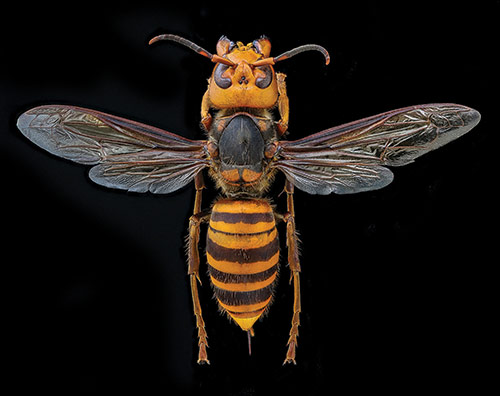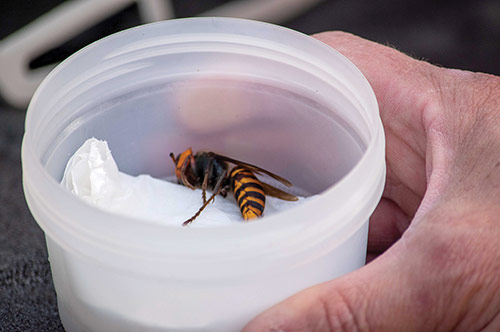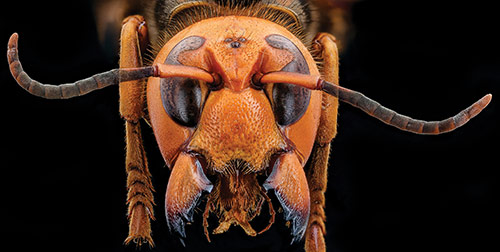Asian Giant Hornet Threat, in Context
 |
|
Asian giant hornet specimen. Photo by USGS Bee Inventory and Monitoring Lab, flic.kr/p/2jNtkss. |
Invasive hornet’s threat to humans may be overhyped, but danger to pollinators is very real
The COVID-19 pandemic was already in full swing earlier this year when news first broke of the Asian giant hornet (AGH) being found in the U.S.
Perhaps it was because of “crisis fatigue” from the ongoing pandemic that the media and public seemed primed to assume the worst about any new perceived threat. Perhaps it had something to do with the colloquial nickname “murder hornet” often hyperbolically used in place of the invader’s legitimate name.
Regardless of the cause, substantive news and facts about AGH may have become obscured by the hype that its arrival elicited.
Danger is Real but Specific
 |
|
Asian giant hornet on ice. Photo by Washington State Department of Agriculture, flic.kr/p/2jTrFdh, CC BY-NC 2.0. |
To be clear, AGH is a threat, but not in the way it is often perceived. Given the sheer size of the insect and the length of its stinger, it is able to penetrate protective outerwear that would stop many other stinging insects, and when it does sting, it administers a particularly large dose of venom. It can be deadly to humans, especially in the case of multiple stings.
However, AGH is not inclined to attack unless provoked, and no humans have been stung or killed by the hornet in the U.S. to date. So far, its range in the U.S. has been limited to a small swath of the west coast. Ongoing efforts aim to prevent it from expanding into new territory.
Pollinator Protection and the Trouble with Lookalikes
A more credible threat posed by AGH is to honey bees, making it a potential factor in pollinator decline and thus impacting the food supply. The hornets can wipe out an entire colony by feeding on the young. In AGH’s native Japan, the bees have evolved behaviors for defending against it, but the U.S. honey bee counterpart has no such defenses.
Further complicating matters is the presence of other wasp species that, to the untrained eye, resemble AGH to varying degrees, but do not pose similar threats.
 |
|
Close-up view of Asian giant hornet specimen. Photo by USGS Bee Inventory and Monitoring Lab, flic.kr/p/2jNvArQ. |
Further Reading
Integrated pest management (IPM) experts have been working to gather and disseminate credible, scientifically accurate information about AGH, what people need to know, and what’s being done about it.
For more information:
“Asian Giant Hornets – A Concern for New York?” (blogs.cornell.edu/nysipm/2020/05/05/asian-giant-hornets-a-concern-for-new-york/), a New York State IPM Program blog post first published in May but updated periodically since.
Asian giant hornet pest alert (www.ncipmc.org/projects/pest-alerts1/asian-giant-hornet/), hosted by the North Central IPM Center and co-developed with the Western IPM Center.
The Northeastern IPM Center promotes integrated pest management for reducing risks to human health and the environment. If republishing our news, please acknowledge the source (“From Northeast IPM Insights”) along with a link to our website.
